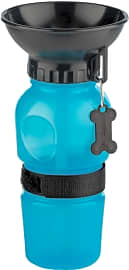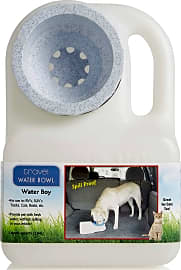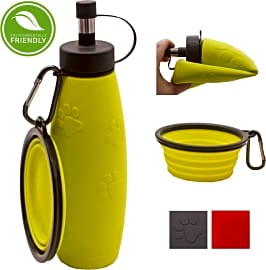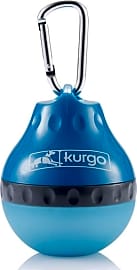The 10 Best Dog Water Bottles

This wiki has been updated 37 times since it was first published in April of 2016. Taking a furry friend with you on a hike or camping trip is one of life's great pleasures. But if you don't want your pup drinking out of polluted streams or ponds, one of these dog water bottles can serve as a safe alternative source of hydration. Many come with serving dishes that make satisfying a dog's thirst easy and convenient, so you can both get on with your adventure. When users buy our independently chosen editorial recommendations, we may earn commissions to help fund the Wiki.
Editor's Notes
March 27, 2020:
I have 3 dogs of my own, so the idea of going somewhere with them for an extended period of time without a portable and alternative source of hydration for them would be akin to me taking myself into parts unknown without a water bottle to keep me from dying of thirst. So while I can't exactly tote my dog's traditional feeding bowls with me on an outdoor adventure, the next best thing is to have a water bottle designed just for him as a practical solution. There are options for both small and large breeds alike that will get the job done.
We've added a variety of new options to the list, each with unique features that promote convenience and easy access to the wet stuff. The Highwave AutoDogMug, for example, utilizes a squeeze-and-release style of operation, allowing any extra water remaining inside its leaf-shaped bowl to drain back into the container for later use once your dog has had its fill. When living in areas with hard water, the activated carbon filters accompanying the Well Life Portable can help rid a pup's water source of certain impurities like chlorine and other chemicals.
When a dog spends a lot of time in the back of a large vehicle (like an RV or SUV), the Lixit Waterboy comes in handy, since flipping it on its side allows water to flow naturally into its companion serving container. The design also keeps the water level low when Fido drinks so that you don't have to spend an inordinate amount of time cleaning up after his spills or dribbles.
Another consideration to keep in mind is that the outdoors provide extreme environments. The last thing you want is a flimsy water bottle that can break easily during a hike in the hot wilderness. For the adventurers at heart, we've included items like the H204K9 Unit. Its silicone outer shell isn't just designed to withstand impacts, but its self-insulating design can maintain a cold water temperature for your pooch throughout the trip.
For additional versatility, we've added the Upsky 2-in-1 due to its separate compartments for food and water, which come in handy during extended travel with a small canine.
Finally, the True Love Sofunii leverages a dedicated valve switch to control the flow of water into its drinking cup. The same switch can be pressed again to allow unconsumed water to run back into the storage bottle.
The Importance Of Dog Water Bottles
If the dog is excessively panting with a dry mouth and thick saliva, this is a sign that it's time to break out the dog water bottle.
Hydration is key to a dog's health. It is a common misconception that simply panting means a dog is thirsty; panting is actually the main way dogs regulate their body temperature. That doesn't mean they won't gladly accept a drink from a dog water bottle on a hike, though; dogs thoroughly enjoy water. But the signs and symptoms of dehydration are different in a dog.
A dehydrated dog will change in appearance. They will appear more sluggish, have sunken eyes, and have a dry, chapped nose. If the dog is excessively panting with a dry mouth and thick saliva, this is a sign that it's time to break out the dog water bottle. Other signs include dark, concentrated urine, vomiting, diarrhea, wobbly legs, and dry, parched skin.
As dogs have yet to develop the ability to speak English, the best we can do is to look for signs and symptoms of their body's dehydration, and be prepared with water. The common method of pouring water into a cupped hand in hopes to hydrate a parched dog may be futile, as dogs scoop water into their mouths using the back of their tongue. This is also why dogs create such a mess when drinking; lapping water is not as easy as they make it look.
A dog water bottle has a much larger chamber than a cupped hand, and is much more convenient for dogs to drink from; thus enabling them to actually quench their thirst when out on a long hike or walking around the neighborhood.
The Health Impact Of Having Dogs
Humans have domesticated animals for thousands of years. The earliest known relationship was a twelve thousand year old human skeleton which was found with its hand on a small wolf cub. While many have assumed the positive health impact of owning companion animals such as dogs, research into the topic was scarce until recently.
When studies were finally conducted, the results were surprising. One study looked at over 400 adults who’d suffered heart attacks. Researchers found that dog owners were significantly more likely to still be alive than were those who did not own dogs.
While many have assumed the positive health impact of owning companion animals such as dogs, research into the topic was scarce until recently.
These results may simply be because of the perception of health benefits from people who have pets. A separate study found that people with pets have significantly lower heart rate and blood pressure than their pet-free counterparts. The study concluded that simply because people believe pets to be important parts of there lives, significant cardiovascular and behavioral benefits are associated with this belief. If nothing else, this shows the power of the human mind to create a beneficial state in the body.
Most dog owners also get more exercise than people without them, as energetic dogs often need walks and hikes to keep them happy. This, of course, makes the person exercise more. One investigation looked at a large sample group, finding that dog owners who regularly walked with their dogs were much less likely to be obese than those who didn’t own dogs.
For those who cannot walk, dogs have proved especially important. Research concluded that both psychological and social status improvements occurred in the lives of people with ambulatory disabilities who were assigned service dogs. Psychological improvements were noted in patients after spending just 6 months with their dogs.
How The Wolf Gave Way To The Dog
With all of the purebred dogs encountered on a daily basis, it is easy to forget that each one is from the exact same species. As they are scientifically called, every dog, from a chihuahua to a great dane, is of the Canis lupus familiaris species. This species is a subsection of the gray wolf, Canis lupus.
They were likely closely related to the coyote, jackal, and other wolves; and mating any of these pairs would produce fertile offspring.
It is interesting to note that while gray wolves are considered the ancestors to house dogs, the genetic links seem to show that both grey wolves and dogs originated from the same wolf/dog ancestor; though this species is not entirely known. Geneticists follow trends from as far back as the Pleistocene era, but there is no distinct link between any one wolf and its evolution into a dog. We know dogs evolved from wolves, we simply don't know which wolves.
The ancient wolf was a highly adaptive species; having evolved over thousands of years to hunt large prey, hunt in packs, and have very expressive behaviors. They were likely closely related to the coyote, jackal, and other wolves; and mating any of these pairs would produce fertile offspring. These original hybrid animals would lead to the domestication of Canis lupus, and the introduction of a domesticated version, our familiar house canine.
Since that time, thanks in part to genetic admixture, and more due to purposeful breeding to produce specific traits, many forms of canine have been created. Humans valued the usefulness of hunting dogs when searching for a fresh kill; or the quiet cleverness of farm dogs who would sniff out rats in the barn. Though the modern versions of canines are often used more for companionship than function, it is fun to note that somewhere locked in their DNA is the ancient wolf we have to thank for their existence.















